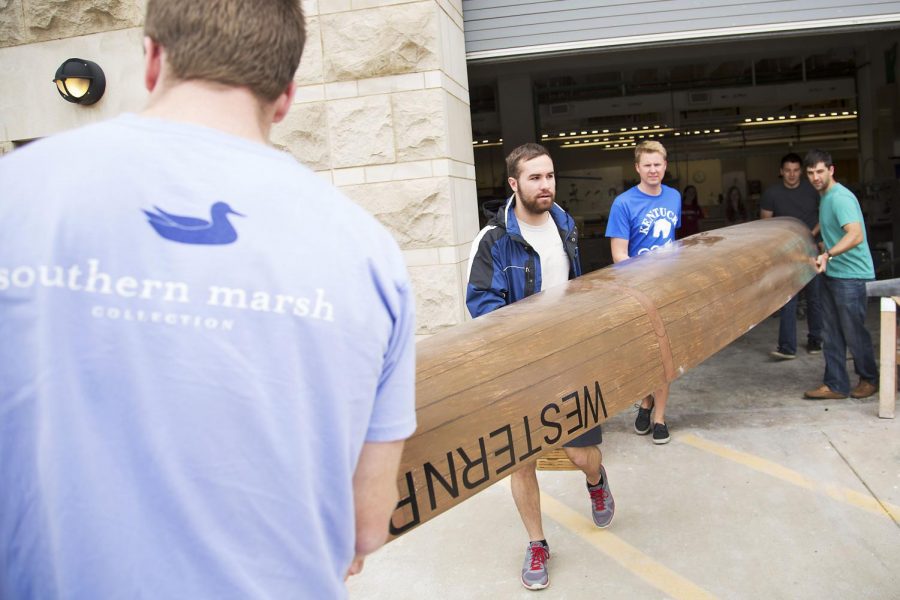“Yes it floats!”: WKU concrete canoe team heads to national contest
April 7, 2015
While some seniors focus on term papers and capstone projects, several students in WKU’s Department of Civil Engineering are trying to get concrete canoes to float.
WKU’s concrete canoe team won its division at the Ohio Valley Student Conference last month, qualifying the team for national events at Clemson University in South Carolina this summer.
These unique canoeing teams have been around for decades, team sponsor Matthew Dettman said. The boats —built with mixtures of cement, lightweight aggregate and chemicals —combine athleticism and engineering skills.
“It is our Super Bowl of civil engineering events,” Dettman, the James D. Scott Professor of Civil Engineering, said. “A lot of universities focus on it because of its unique nature. You hear concrete canoe and you’re like ‘seriously?’”
Senior Dylan Jones, a civil engineering major from Berea, has been involved with the team since his freshman year. Jones served as one of the team’s captains and said this is the team’s first time qualifying for nationals since he joined.
“It’s really competitive,” Jones said. “We’re really excited to go to nationals. Normally we always get second or third place.”
Teams must construct their canoes to withstand multiple races, including turns, Dettman said. Sprint races are 100 meters down and back. The endurance trial begins with 600 meters weaving between slalom buoys and another 500 meters to paddle.
The construction process is lengthy. A form must be built like an upside down canoe out of wood and styrofoam, Dettman said. A concrete reinforcement goes around the form to set up for two weeks.
The pouring process alone proved to be the most strenuous and one of the most important. Jones said pouring the mixture for the final canoe took 18 hours total.
“We have to pre batch the materials for the mix and on pour day we mix it using an industrial-style cooking mixer,” he said. “Twelve of us pour three layers of concrete on the canoe. After it’s cured, we sand and stain it.”
The pouring process averages about 15 to 20 hours and is crucial to the success of the team.
“If you don’t pour it right, none of your analysis actually matters,” Dettman said. “It’ll just fall apart.”
Making sure the canoe stays together isn’t the only responsibility for engineers on the project. The canoe itself must follow strict length, width and weight stipulations set by the American Society of Civil Engineers National Concrete Canoe Competition. Maximum width is 36 inches, maximum length is 22 feet and other measurements vary depending on style of the boat, according to the ASCE’s 2015 rules and regulations.
Even despite the labor and precautions, the canoe could always fall apart. Dettman said it’s not uncommon to see final canoes break apart mid-race.
“We’ve seen some not make it through to the finish line,” he said.
Jones noted the concerns are always there.
“Our practice canoe fell apart when we took it out to paddle,” Jones said. “We changed the whole canoe for the final pour… Spending 18 hours for nothing is a fear, but we were pretty confident it would work.”
Dettman said seniors contribute a majority of the design and construction.
“Since it’s mostly seniors and we use it in our senior design course, it really encompasses a lot of facets of civil engineering,” he said. “It’s like taking an engineering project from conception to completion and using the product and supporting and proving what you did actually works. It’s the ideal senior capstone process.”
Dettman said the biggest payoff as an advisor is seeing the cooperation and collaboration between team members.
“To see our kids successfully complete the course and do really well brings a lot of pride,” he said.
Jones, who is graduating in May, said he wants to continue concrete canoeing.
“It’s really fun and I enjoyed doing it even though there’s a lot of work,” he said. “I see myself helping other teams in the future.”




















![Megan Inman of Tennessee cries after embracing Drag performer and transgender advocate Jasmine St. James at the 9th Annual WKU Housing and Residence Life Drag Show at Knicely Conference Center on April 4, 2024. “[The community] was so warm and welcoming when I came out, if it wasn’t for the queens I wouldn’t be here,” Inman said.](https://wkuherald.com/wp-content/uploads/2024/04/smith_von_drag_3-600x419.jpg)


